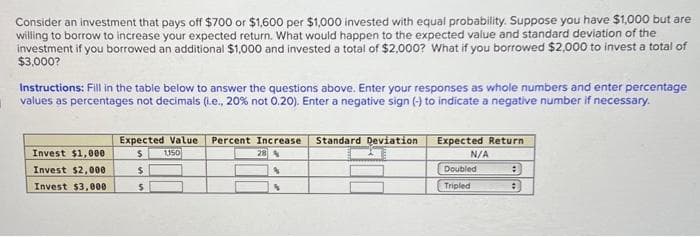Consider an investment that pays off $700 or $1,600 per $1,000 invested with equal probability. Suppose you have $1,000 but are willing to borrow to increase your expected return. What would happen to the expected value and standard deviation of the investment if you borrowed an additional $1,000 and invested a total of $2,000? What if you borrowed $2,000 to invest a total of $3,000? Instructions: Fill in the table below to answer the questions above. Enter your responses as whole numbers and enter percentage values as percentages not decimals (.e., 20% not 0.20). Enter a negative sign (-) to indicate a negative number if necessary. Invest $1,000 Invest $2,000 Invest $3,000 Expected Value Percent Increase Standard Deviation $ 1150 28 % $ 8 B $ Expected Return N/A Doubled Tripled :
Consider an investment that pays off $700 or $1,600 per $1,000 invested with equal probability. Suppose you have $1,000 but are willing to borrow to increase your expected return. What would happen to the expected value and standard deviation of the investment if you borrowed an additional $1,000 and invested a total of $2,000? What if you borrowed $2,000 to invest a total of $3,000? Instructions: Fill in the table below to answer the questions above. Enter your responses as whole numbers and enter percentage values as percentages not decimals (.e., 20% not 0.20). Enter a negative sign (-) to indicate a negative number if necessary. Invest $1,000 Invest $2,000 Invest $3,000 Expected Value Percent Increase Standard Deviation $ 1150 28 % $ 8 B $ Expected Return N/A Doubled Tripled :
Chapter7: Uncertainty
Section: Chapter Questions
Problem 7.9P
Related questions
Question

Transcribed Image Text:Consider an investment that pays off $700 or $1,600 per $1,000 invested with equal probability. Suppose you have $1,000 but are
willing to borrow to increase your expected return. What would happen to the expected value and standard deviation of the
investment if you borrowed an additional $1,000 and invested a total of $2,000? What if you borrowed $2,000 to invest a total of
$3,000?
Instructions: Fill in the table below to answer the questions above. Enter your responses as whole numbers and enter percentage
values as percentages not decimals (.e., 20% not 0.20). Enter a negative sign (-) to indicate a negative number if necessary.
Invest $1,000
Invest $2,000
Invest $3,000
Expected Value Percent Increase Standard Deviation
1150
S
28 %
$
8
%
$
Expected Return
N/A
Doubled
Tripled
:
#
Expert Solution
This question has been solved!
Explore an expertly crafted, step-by-step solution for a thorough understanding of key concepts.
This is a popular solution!
Trending now
This is a popular solution!
Step by step
Solved in 3 steps

Knowledge Booster
Learn more about
Need a deep-dive on the concept behind this application? Look no further. Learn more about this topic, economics and related others by exploring similar questions and additional content below.Recommended textbooks for you


Managerial Economics: A Problem Solving Approach
Economics
ISBN:
9781337106665
Author:
Luke M. Froeb, Brian T. McCann, Michael R. Ward, Mike Shor
Publisher:
Cengage Learning

Managerial Economics: Applications, Strategies an…
Economics
ISBN:
9781305506381
Author:
James R. McGuigan, R. Charles Moyer, Frederick H.deB. Harris
Publisher:
Cengage Learning


Managerial Economics: A Problem Solving Approach
Economics
ISBN:
9781337106665
Author:
Luke M. Froeb, Brian T. McCann, Michael R. Ward, Mike Shor
Publisher:
Cengage Learning

Managerial Economics: Applications, Strategies an…
Economics
ISBN:
9781305506381
Author:
James R. McGuigan, R. Charles Moyer, Frederick H.deB. Harris
Publisher:
Cengage Learning